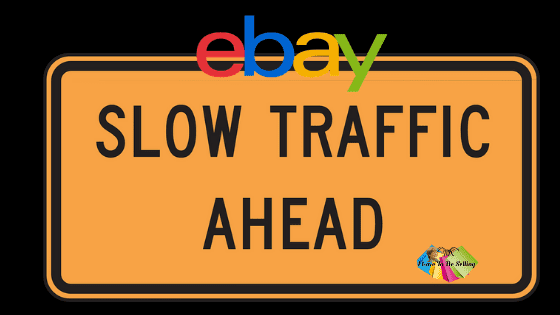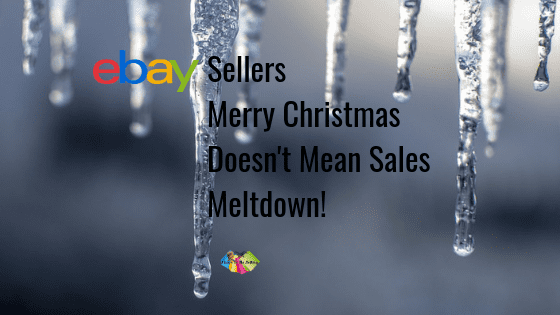
by Kathy Terrill | May 15, 2019 | eCommerce Tips, Selling on eBay
Have your eBay sales slumped recently?
Ever wonder whether you’re the only seller experiencing a drop in eBay sales? Well, wonder no longer…because ShelfTrend’s new Recent Sales Report can help you get to the bottom of why your sales seem to be bottoming out!
There are lots of reasons for a slowdown in eBay sales.
It’s important to dive in and find out what is going on. Maybe there are just less buyers on eBay for your product right now. Maybe there was a change to eBay’s Best Match algorithm, so not as many buyers are finding your listing. Perhaps your price is too high. Or (worse yet), perhaps your product is losing its appeal.
It all adds up to lots of lost sleep while you fret and fume over the question of what’s causing eBay sales to drop.
But ShelfTrend subtracts those worries from the equation. All you have to do is search by keyword, category, competitor, or product identifier. Then ShelfTrend’s Recent Sales Report will show you the Last 7 Days, Last 30 days, and Month to Date sales for the Top 100 Listings as ranked by Best Match: number of items sold, revenue, and pricing.
ShelfTrend‘s eBay sales data is super-easy to use and understand, too.

Using ShelfTrend’s eBay data is super easy and helps you know why your eBay sales have slowed down!
ShelfTrend boils down the complexities first, doing the analysis for you and presenting you with the results. You don’t even need a spreadsheet!
The information in this report is extremely revealing. ShelfTrend’s Recent Sales Report makes it as easy as 1-2-3 for you to:
- Compare your own eBay sales to those of your competitors.
Learn how you could improve your listing, pricing, or even your product to regain lost sales.
- Identify who and what is dominating search results and sales. Detailed sales analytics for brands, products, and competitors give you an idea of emerging trends and what’s hot on eBay right now.
- Evaluate the overall market.
Use the interactive chart — which charts sales volume, sales revenue, and median price — to understand whether the market is experiencing growth, or if everyone is in the same boat with having a drop in sales.
You can search, sort, and filter — e.g., by listing format or condition — to drill down further.
This enables you to uncover critical insights that could change the way you source, price, and sell.
You can also download Recent Sales data as an Excel spreadsheet to glean even more detailed metrics, including item specifics, buyer location, and — soon — product variant. It’s an invaluable tool for assessing the performance of your products and your competitors.
But wait, there’s more! When you sign up for ShelfTrend and run the Recent Sales Report, you also get ShelfTrend’s other reports:
- Top 500 Live Listings Report
- New Listings Report
- Supply Demand Report
When you run these reports together for the same keyword search, category, or competitor, you get a wonderfully well-rounded, real-time perspective on what’s really happening on eBay — not what you guess or hear rumors is happening.
The story behind this ecommerce market data company is both interesting and inspiring.
ShelfTrend was founded by former eBay executives Anojan Abel and Lisa Wong, who worked closely with sellers. Between the 2 of them, they had nearly 20 years of experience with the platform. Their epiphany came when they were asked to figure out why one seller had seen a recent decline in sales over recent weeks, despite not changing anything about their listings.
The seller suspected that the drop in sales might be due to a change in eBay’s Best Match search algorithm.

If your eBay sales have slowed, do you know why?
But a closer analysis of sales data revealed that in fact, a competitor had snuck in and begun listing similar products at lower prices. Because the seller had no easy way to spot this change in the marketplace, they missed critical activity within their category. The result? A huge disruption of their business!
Realizing that even the most seasoned sellers could be caught off-guard when they’re flying blind, Anojan and Lisa created ShelfTrend to help sellers stay on top of their sales.
They’ve got live marketplace data for more than a billion listings in thousands of categories from over 20 eBay countries. Their goal is to arm sellers with the analytics they need to make data-driven decisions about listing and selling on eBay — and to help them stay ahead of their competition.
Now, thanks to ShelfTrend’s suite of marketplace reports, you can identify, research, and monitor your competitors and their selling activity.
You can also analyze market movements to uncover emerging new products and competitors or gauge shifts in demand.
In addition, ShelfTrend lets you benchmark your business. You’ll know where you stand among sellers of similar products, and you can look for opportunities to improve your search ranking, drops in listings, or price changes.
Furthermore, ShelfTrend helps you find profitable niches by highlighting supply gaps vs. buyer demand.

ShelfTrend quickly identifies what IS selling on eBay!
Look at it this way: You can spend hours on eBay marketplace research and not be able to see the forest for the trees. Or you can let ShelfTrend do the work for you and get actionable results, including their new Recent Sales Report. Try ShelfTrend’s Basic Plan for free at ShelfTrend.com.
Take action with ShelfTrend to reignite your eBay sales!

by Kathy Terrill | May 4, 2019 | eCommerce News, eCommerce Selling Tips, eCommerce Tips, Selling on eBay
eBay’s Spring Seller Update for 2019 is live. And it contains lots of good news for sellers.

eBay’s Spring Seller Update 2019 is Live!
Here are some of the benefits in eBay’s Spring Seller Update:
- Expanded seller protections
- Continued expansion and rollout of Managed Payments
- Enhancements to marketing tools
- Marketplace improvements
- Updates to inventory optimization
However, let’s take a closer look at eBay’s Spring Seller Update. We’ll start with eBay’s promise regarding added seller protections.
In this seller update, eBay speaks to implementing stronger measures against abusive buyers (such as those who claim an item is not as described in order to score a free return). However, they don’t explain how they plan to do so. More clarity on this would be appreciated.
Also eBay now makes it easier to report buyers for specific offenses. Furthermore, eBay will reduce search visibility for sellers who violate eBay’s drop-shipping policy by using another retailer to ship purchased items directly to buyers.
These are welcome improvements, but again, sellers need to know how they’ll translate into safeguards for good sellers. It will be nice to see how eBay adds to these somewhat vague promises of standing behind its sellers. Sellers will continue to look for strong, clear and effective Seller Protections in future site updates.
I speak to this in my YouTube eBay Spring Seller Update 2019 – What Seller Protection?
Now, let’s move on to the continued roll out of Managed Payments.
Managed Payments adds revenue to eBay. This is cited in eBay’s 2019 1st quarter earnings report. Understandably, eBay is offering Managed Payments to more sellers as quickly as it can. Google Pay is available to shoppers through Managed Payments as of April 2019. Also Paypal is now launching on a test basis through Managed Payments. You can express your interest in Managed Payments here. Most sellers should be opted in by 2021.
In addition, new user-friendly order numbers will be introduced this summer to help you track and manage orders more efficiently.
Last but not least, starting this July, you’ll be able to refund a percentage of the order amount — up to 100% — from Seller Hub.
Now for some really good news.
For starters, Promoted Listings, eBay’s paid search, is now available to sellers whether you have an eBay store or not. Promoted Listings increases your listings visibility in eBay search results. You pay your chosen rate (percentage of the sale price) whenever a buyer clicks on your Promoted listing, then purchases that item within 30 days.
eBay provides guidance for choosing ad rates as well as detailed sales metrics. Sellers create a campaign from your Active Listings page in Seller Hub. Sales are monitored on your Manage Orders page. Learn all about Promoted Listings here.
More goodness for sellers. It’s all about Seller Hub. Starting May 2019, you can bulk-edit and filter Active Listings by Best Offer. Ditto for “Offer to Buyers”, which sends offers to watchers.
Furthermore, you can also edit Volume Pricing into or out of listings from a handy drop-down menu. Now available to all sellers, Volume Pricing lets you set discounts for multiple purchases of multi-quantity items. As of this update, it works with multi-variation listings, too.

Sellers score with more options to the successful tool Volume Pricing!
This will have you doing the Happy Dance sellers.
Starting in July of 2019, Good ‘Til Cancelled (GTC) listing fees will be billed by the calendar month instead of every 30 days!
In addition, in your eBay Seller Hub, you can customize your Active Listings page to add the “Start date” column. This will show you how long each GTC product listing has been active on the site. To see your GTC listings’ auto-renewal dates, add the “End date” column. Now, that’s easey peasey. Thanks eBay! While short term listings are not available in the fixed price format, you can create shorter duration listings for auction listings.
There is news for eBay inventory optimization standards.
Category and item specific updates will affect key categories. All the categories are listed here.Be sure to list your items in “best fit” categories as mandated by eBay.
All in all, the Spring Seller Update of 2019 has good news for sellers.
Seller tools continue to evolve with welcome additions to Best Offer and Volume Pricing. More sellers are being opted into eBay’s Managed Payments. Managed Payments offers more attractive check out choices to shoppers. Note Managed Payments for now does not include International Transactions.
The one disappointment is the “new” Seller Protections. It’s great hearing how eBay stands by its sellers. But there is no new program, or step by consequences laid out for bad buyers. eBay promises more consequences to bad buyers. Sellers will watch eBay, to see if they follow through with substance for these “promised” seller protections.

eBay sellers are looking for promised seller protections.
Meanwhile, read eBay’s 2019 Spring Seller Update here, then decide how to make these new initiatives work for your business.

by Kathy Terrill | Apr 12, 2019 | eCommerce Tips, Pinterest Tips for online sellers!, Social Media Tips
eBay sellers turn to Pinterest for it’s sales power.
It is a fruitful and profitable social media platform for eBay sellers. That is because your Pinterest pins live on for a very long time. This means that the time and effort you spend posting there will pay sales dividends for weeks, months, even years to come. Your pins done correctly will continue to direct buyers to your online products for a long, long time. So, your time spent pinning what you sell, is time well spent.
According to digital marketing agency Omnicore , there are more than 250 million Pinterest users worldwide.

There are 250 million pinners worldwide!
Half of them live in the USA, and 2 million of them save shopping pins every day. So, that’s a lot of prospective buyers!
But there’s recently been a big change in how pins work.
Seller used to be able to edit the address (URL) of their pins to direct traffic to a category in their eBay store, or to a search within their eBay store, once a one-off item sold. This was very helpful for sellers of unique items.
But that’s no longer the case.
When you pin to Pinterest with either Pinterest’s browser extension or eBay’s Share button, the address leading to the exact item is displayed to shoppers. That’s great if you’re selling multiple quantities of something, but not so great for sellers who have only one of an item. Here’s why: Once your item sells out, if a Pinterest user clicks on your pin, eBay will redirect them to similar items. For example, if your pin was for a red shirt, eBay shows them other red shirts.
But eBay doesn’t necessarily redirect the Pinterest user to your items; they direct them where eBay thinks best for eBay!
I explain how this works in my video, “What Happened To Pinterest?”
You’ve done the work, but you don’t reap the sales ad traffic benefits.
So what to do? First, build a pin . It takes about 5-10 minutes to learn how to do so; once you get the hang of it, it’s a snap. Basically, you upload your photo, then write a title and description. But for the URL, instead of the listing’s web address, put your nearest eBay store category’s URL or the link to a search in your store. If you don’t have an eBay store, then your best bet is to use the URL for your seller ID.
I give all the details and show you how to do this in my above YouTube video “What Happened to Pinterest? HUGE Impact for Sellers!”
Sellers, you deserve the sales from your social media work. Check out my YouTube, so you don’t lose sales because of this new change to Pinterest. Then get busy pinning!

by Kathy Terrill | Jan 8, 2019 | eCommerce Tips, Facebook Business Page Tips, Selling on eBay, Social Media Tips
First off, what are trending New Year’s hashtags that sellers want for 2019?
I’ve got some fresh new advice on the best New Year’s hashtags for eBay sellers. Sellers can use these hashtags to start 2019 with great engagement to drive sales. What sellers doesn’t want to start the year with lots of customers?!
To begin, where do you find the hottest hashtags?

How do sellers find the best hashtags for social media?
Look on Twitter for trending hashtags there; you’ll find them in the left-hand sidebar in the desktop version of Twitter.
Hashtags are topics and keywords that you can find on social media.
They’re distinguished by a pound sign before the first word or words. A hashtag is frequently a keyword, and vice versa. A keyword is a word used by a potential customer to find a certain item.
You want to find the hottest hashtags, therefore look for those that are trending.
Trending hashtags reveal what is most popular on social media — i.e., what people are talking about and looking for right now. Can you tie in any of the products you have listed for sale? Using popular hashtags and keywords in your products posts on social media gives them “search juice”.
So, trending hashtags gets you more views, likes, clicks, retweet and sales.
For instance, sports events and award shows are always big. Are your followers sports fans? Many folks are. Do you have clothing, shoes, home décor, collectibles or other items that they might like? If so, include the trending hashtags in your product tweet. One or two hashtags work best for Twitter.
Check Facebook to see if the Twitter trending hashtag/keyword is popular there as well.
Do a search for that hashtag, and find out. Chances are it is; great, then post your item(s) on Facebook too. Change up your post a bit for Facebook, because you don’t want to spam your followers.
Now investigate Instagram.
There you can include 11 to 30 hashtags with each post. However, do make your posts fresh again for that site, so they don’t come across as spam.
In closing, the artful use of relevant and apropos trending hashtags/keywords gets you views, clicks, and sales. Best of all, using social media this way is absolutely free.
So don’t be shy. Go forth, find the hottest hashtags of the new year, and post – post –post your items on Twitter, Facebook, and Instagram!

Get your sales jumping with the hottest hashtags on social media!

by Kathy Terrill | Dec 19, 2018 | eCommerce News, eCommerce Tips, Selling on eBay
eBay sellers, Merry Christmas is just one week away.
If you’ve been watching the calendar, this shouldn’t come as a shock to you. But you still might need to sit down before I spell it out to you: Christmas is just one short week away.
What does that mean for you and your business on eBay? Does it mean a sales meltdown?
Before we get started, take a few deep breaths. There are tried-and-true strategies to help you make the most of this very limited once-a-year time. I’m going to share them with you.
First, be smart about where you get eBay listing and inventory information.
Sadly there is much bad information on social media that can harm your eBay business. Avoid losing sales with inaccurate tips. I talk about this in my YouTube, eBay Sellers You May Not Want To Hear This..
Second, make sure you offer paid expedited shipping options. This includes ALL of your listings. If not, bulk-edit them into your listings right now using eBay’s bulk edit tool. You can also use eBay business policies to accomplish this. There, that was easy-peasy!
Third, quickly review your holiday-appropriate inventory. If it’s not selling, then now is definitely the time to figure out why. Is it priced too high? Are your photos less than stellar, or are there just too few of them? Is your item one of many that may have glutted the market for them? Or is it just not getting found in search?
It’s probably too late to do much about your photos (unless you’re super fast with a camera), but you can definitely do something about the other reasons an item may not yet have sold or is selling very slowly. Here are some options:
- If you have an eBay store, Rrun a deeply discounted flash sale using Markdown Manager. Promote your sale on social media with a link to your store. Instagram, Facebook, and Twitter are your best choices for getting traction — and traffic! — ASAP. You can even run multiple flash sales throughout this final shopping week.
- eBay store owners, use Promotions Manager to set up a BOGO (buy one, get one free) or other volume-based discount. Here’s my YouTube Ignite Your eBay Sales With Promotions Manager.
- With an eBay store, create some Promoted Listings, and consider setting your ad rate slightly higher than the trending percentage.
- With or without an eBay store, try bundling your holiday items. For example, could you put together a selection of inexpensive items and call it a “Secret Santa Gift Lot”? My hit guide Secret Sauce For eBay Sales transforms slow moving inventory into hot bundles.

Secret Spice for Online Sales turns slow listings into hot bundles!
Yes, ‘tis the week before Christmas, and you’re going to be busy-busy-busy…but don’t let the next seven days be all business and no pleasure.
Whatever doesn’t sell this Q4 can have its listing tweaked in the new year. Those items still be there on your store shelves, but each day of this week will only happen once.
In closing, put these profit-maximizing strategies to work. But don’t shortchange yourself on spending time enjoying family, friends, and all the joys of the season. Best of luck with your last-minute selling.
Happy Holidays and Merry Christmas eBay sellers.
















